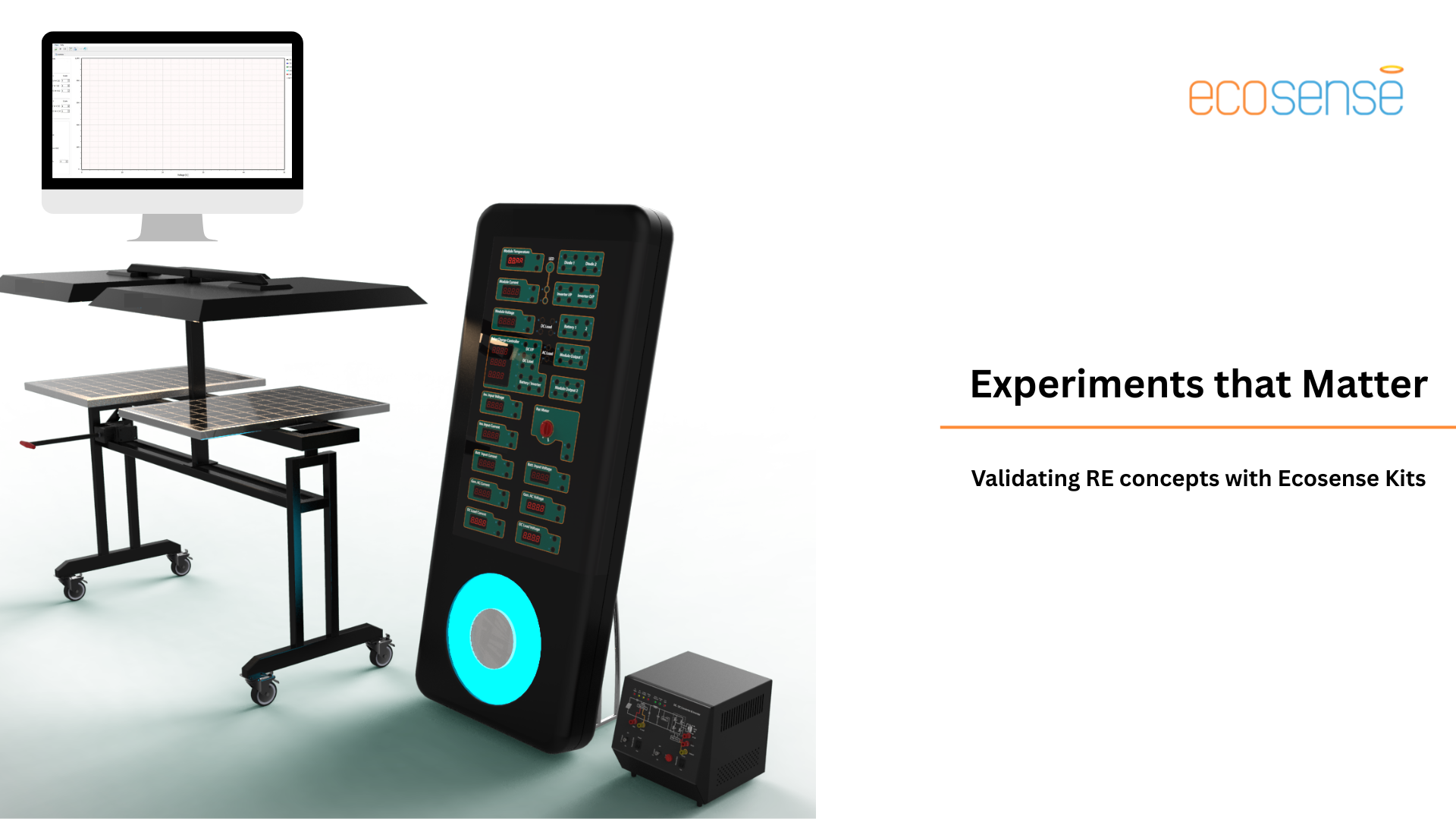Experiments That Matter: Validating Renewable Energy Concepts with Ecosense Kits
In renewable energy education, there is a vast difference
between understanding a concept and proving it with your own hands.
While lectures and theory provide the foundation, it is the lab experiments
that breathe life into learning. This is especially true in the
fast-evolving world of solar, wind, hydrogen, and battery-based systems, where
practical know-how is just as critical as academic understanding.
At Ecosense, we believe that renewable energy labs
should do more than demonstrate—they should validate, challenge
assumptions, and spark innovation. Our kits are designed to help
students and researchers not just observe energy systems, but to interact with
them, measure real-world variables, and apply engineering logic. In this blog,
we explore the kinds of experiments that truly matter, and how Ecosense
kits bring them to life in classrooms and labs across the country.
Why Experiments Are the Cornerstone of RE Education
Renewable energy is inherently multidisciplinary. It
combines:
- Electrical
systems (generation, conversion, storage)
- Mechanical
elements (turbines, rotors, trackers)
- Environmental
conditions (solar radiation, wind profiles, temperature)
- Power
electronics and embedded systems (MPPTs, converters, controllers)
For students to become industry-ready, they must learn how
these components behave under real-world conditions. They must analyze:
- Efficiency
vs. angle of incidence in a PV panel
- Wind
turbine RPM vs. blade pitch
- Impact
of partial shading on a solar array
- The
effect of ambient temperature on battery voltage
- Load
balancing in a hybrid microgrid
These are not just textbook questions—they are
engineering decisions. And they are best answered in a lab with live
experiments, not simulations alone.
Key Experiments with Ecosense Kits Across RE Domains
Our renewable energy training systems are designed to
deliver meaningful, modular experiments that validate both fundamental
and advanced concepts.
Solar PV Training
System
- I-V
and P-V Curve Analysis: Students plot real-time characteristics and
study the influence of irradiance and temperature.
- MPPT
Algorithm Comparison: Observe how Perturb & Observe (P&O) and
Incremental Conductance (InC) track maximum power.
- Partial
Shading Analysis: Use bypass diodes and simulate module-level shading
to assess string performance.
- Series
vs. Parallel Configuration: Compare voltage and current output and
understand implications for inverter design.
- Tilt
Angle Optimization: Measure power output across different panel tilt
angles.
Wind Energy Training System
- RPM
vs. Wind Speed Curve: Use the wind tunnel to analyze turbine
performance under different conditions.
- Tip
Speed Ratio (TSR) Calculation: Validate the optimal operating point
for maximum power extraction.
- Blade
Pitch and Swept Area Impact: Test how aerodynamic design affects power
generation.
- AC/DC
Output Measurement: Evaluate the behavior of the generator under
varying loads.
- Battery
Charging via Wind: Understand the intermittent nature of wind and its
effect on storage systems.
Battery Energy Storage System
- State
of Charge (SoC) and Depth of Discharge (DoD): Calculate and track how
battery life is affected over cycles.
- Charge/Discharge
Efficiency: Plot Coulombic efficiency and round-trip energy loss.
- Temperature
Impact: Run controlled charge/discharge cycles at different ambient
temperatures.
- Hybrid
System Performance: Integrate solar or wind with the battery to
simulate hybrid microgrids.
Grid-Tied Inverter Experiments
- Synchronizing
with Grid: Observe how phase, voltage, and frequency are matched.
- Total
Harmonic Distortion (THD) Analysis: Validate inverter quality and
compliance with grid codes.
- Reactive
Power Compensation: Study inverter behavior in real and reactive power
balancing.
- Island
Detection and Anti-Islanding: Demonstrate grid disconnection safety
protocols.
Microgrid Simulation
- Load
Sharing Among Sources: Solar, wind, and battery supplying loads under
varied conditions.
- Fault
Simulation and Zone Isolation: Trigger faults in one zone and observe
system response.
- Demand
Side Management: Prioritize loads based on generation and storage
availability.
- Energy
Flow Analysis: Track real-time power flows using the integrated
SCADA/data logger.
Green Hydrogen & Fuel Cell Experiments
- Electrolysis
Efficiency: Measure voltage, current, and hydrogen output over time.
- Effect
of Water Purity and Temperature: Validate performance variation under
different inputs.
- Fuel
Cell Performance Mapping: Generate I-V and power curves under
different loads.
- Hydrogen
Storage and Retrieval: Study safe collection and utilization in a
closed-loop system.
- Hybrid
Integration: Combine hydrogen with battery or PV to simulate clean
microgrids.
The Role of Data Logging and Analytics
All Ecosense kits come with data acquisition systems
that allow students to:
- Plot
graphs in real time
- Analyze
experimental trends
- Export
CSV data for research
- Compare
experimental vs. theoretical results
- Generate
lab reports and project documentation
This data-driven approach encourages engineering thinking—not
just following steps, but analyzing outcomes and proposing improvements.
From Classroom to Research Lab
Whether it’s a B.Tech solar lab, a PhD research project on
hydrogen storage, or an M.Tech thesis on microgrid resilience, Ecosense kits
provide the scalability and flexibility needed. Our clients use them to:
- Train
students in core concepts
- Enable
multidisciplinary projects
- Collaborate
with industry partners
- Support
faculty-led research and publishing
- Run
national-level innovation challenges or hackathons
Because our kits use real components and open control
systems, institutions can continuously expand, modify, or upgrade
experiments without vendor lock-in.
Labs Should Do More Than Demonstrate—They Should Validate
Experiments that truly matter do not just show what is
supposed to happen—they test what actually does happen. They encourage
curiosity, critical thinking, and creativity. They prepare students not just
for exams, but for solving real-world challenges in clean energy.
At Ecosense, we are committed to designing lab kits that do
not just teach—but transform. Kits that measure what matters, scale with
your needs, and help validate the energy systems that will power our
sustainable future.
Looking to set up or upgrade your renewable energy lab?
Let us design experiments that leave a lasting impact.

